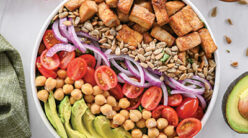Variety is the spice of life—unless you’re a toddler who demands dinosaur-shaped chicken nuggets and mac ’n’ cheese at every meal. Picky eating isn’t uncommon among youngsters, but that doesn’t make the issue any less frustrating for parents. Here are some ways you can make healthy foods more attractive to kiddos:
Taste test.
“Hey, what’s that funny star-shaped fruit?” Take advantage of your child’s natural curiosity. Explore the produce section at the grocery store. Talk about the origin of different foods, and suggest that your child choose something for the family to try.
“Make a game out of trying new foods. Encourage children to try at least one bite,” says registered dietitian Lynn Kistler. “Focus more on the color, shape, feel, texture, or smell of the new food rather than the taste.”
Cook together.
Kids can tear lettuce leaves, stir ingredients, and wash fruits and vegetables.
“When they’re involved in the cooking process, they’re often more likely to try what they’ve helped create,” says Kistler.
Strike while the iron is hot.
Tummies growling while you’re prepping dinner? Set out a plate of fresh-cut fruits and vegetables with peanut butter, hummus, or salad dressing for your hungry brood to munch on while you finish meal prep.
Add a “ta-da!”
Present food in playful ways. Cut sandwiches into stars with a cookie cutter. Ta-da! Offer “ants on a log” with celery, peanut butter, and raisins. Voilà! And serve food on kid-sized plates and bowls featuring their favorite characters, suggests Joan Sechrist, PhD, a registered dietitian.
Do as I say . . . and as I do.
Introduce small bites of new foods alongside foods that your child already likes. For example, when you dine out, invite them to try a bite of whatever you’re eating.
“If children witness their parents eating a varied, nutrient-dense diet in a genuine way––not because they’re eating ‘diet food’ to lose weight––children will be more likely to follow through as well,” says Crystal Witte, a registered dietitian and nutritionist.
Offer them variety—and choice.
Establish a meal routine that integrates a variety of colorful fruits and vegetables. And “allow children to serve themselves. It gives them some control at mealtime,” Sechrist says.
Shhh . . . don’t tell.
“As a last resort, you can sneak fruits and veggies into fun foods they like,” Kistler says. Add chopped up broccoli or peppers to quesadillas, or puree veggies, like cauliflower or squash, into spaghetti sauce.
Be patient.
Taste buds evolve over time. “Instead of expecting your child to eat all of her broccoli, ask her to try just one bite. Over time, your child is more likely to develop a taste preference for that food. Repeated exposure is key,” Witte says.
Freelance journalist Christa Melnyk Hines and her foodie husband are the parents of two growing boys who love to eat. Christa’s favorite part of the day is connecting with her family over dinner.






